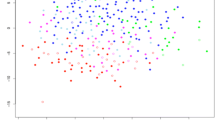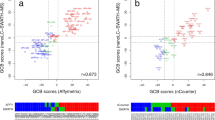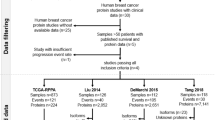Abstract
There are no known morphologic characteristics, cytogenetic aberrations, or molecular alterations predictive of dedifferentiation in liposarcomas. Identification of such a prognostic marker could potentially affect surgical and adjuvant therapy and/or follow-up surveillance for these patients. Two-dimensional difference gel electrophoresis was utilized to characterize protein expression patterns in lipoma, atypical lipomatous tumor (ALT), and the well-differentiated components of dedifferentiated liposarcoma (DDL). Protein spots were identified by peptide mapping/fingerprinting using matrix-assisted laser desorption ionization time-of-flight mass spectrometry. No significant differences in protein expression were identified between lipoma and ALT or DDL. Proteins that were significantly down-regulated in the well-differentiated component of DDL compared to ALT included mitochondrial aldehyde dehydrogenase 2 (ALDH2, >3-fold reduction) and selenium-binding protein-1 (SELENBP1, >4-fold reduction). Subsequent validation studies were performed by immunohistochemistry (IHC) on a separate series of ALT (n = 30) and the well-differentiated components of DDL (n = 28). IHC stains were evaluated in a semi-quantitative manner, and the results were analyzed using the Mann–Whitney test and receiver–operator curve analysis. Decreased IHC staining for SELENBP1 in the well-differentiated component of DDL was confirmed. Cytoplasmic ALDH2 levels determined by IHC were not significantly different in ALT and DDL; no nuclear staining for ALDH2 was observed. Expression of SELENBP1 is decreased in the well-differentiated component of DDL compared to ALT. However, variability in the staining patterns in liposarcoma precludes its use as a predictive marker for dedifferentiation.




Similar content being viewed by others
References
Dei Tos A, Marino-Enriquez A, Pedeutour F, Rossi S (2013) Dedifferentiated liposarcoma. In: Fletcher CDM, Bridge JA, Hogendoorn PCW, Mertens F (eds) WHO classisification of tumours of soft tissue and bone. IARC, Lyon, pp 37–38
Dei Tos AP, Pedeutour F (2013) Atypical lipomatous tumour. In: Fletcher CDM, Bridge JA, Hogendoorn PCW, Mertens F (eds) WHO classisification of tumours of soft tissue and bone. IARC, Lyon, pp 33–36
Azumi N, Curtis J, Kempson RL, Hendrickson MR (1987) Atypical and malignant neoplasms showing lipomatous differentiation: a study of 111 cases. Am J Surg Pathol 11:161–183
Evans HL, Soule EH, Winkelmann RK (1979) Atypical lipoma, atypical intramuscular lipoma, and well differentiated retroperitoneal liposarcoma: a reappraisal of 30 cases formerly classified as well differentiated liposarcoma. Cancer 43:574–584
Kindblom LG, Angervall L, Fassina AS (1982) Atypical lipoma. Acta Pathol Microbiol Immunol Scand A 90:27–36
Kooby DA, Antonescu CR, Brennan MF, Singer S (2004) Atypical lipomatous tumor/well-differentiated liposarcoma of the extremity and trunk wall: importance of histological subtype with treatment recommendations. Ann Surg Oncol 11:78–84
Lucas DR, Nascimento AG, Sanjay BK, Rock MG (1994) Well-differentiated liposarcoma: the Mayo Clinic experience with 58 cases. Am J Clin Pathol 102:677–683
Rosai J, Akerman M, Dal Cin P et al (1996) Combined morphologic and karyotypic study of 59 atypical lipomatous tumors: evaluation of their relationship and differential diagnosis with other adipose tissue tumors (a report of the CHAMP study group). Am J Surg Pathol 20:1182–1189
Rozental TD, Khoury LD, Donthineni-Rao R, Lackman RD (2002) Atypical lipomatous masses of the extremities: outcome of surgical treatment. Clin Orthop Relat Res 398:203–211
Weiss SW, Rao VK (1992) Well-differentiated liposarcoma (atypical lipoma) of deep soft tissue of the extremities, retroperitoneum, and miscellaneous sites: a follow-up study of 92 cases with analysis of the incidence of "dedifferentiation". Am J Surg Pathol 16:1051–1058
Fletcher CD, Akerman M, Dal Cin P et al (1996) Correlation between clinicopathological features and karyotype in lipomatous tumors: a report of 178 cases from the Chromosomes and Morphology (CHAMP) Collaborative Study Group. Am J Pathol 148:623–630
Dal Cin P, Kools P, Sciot R, De Wever I, Van Damme B, Van De Ven W, Van Den Berghe H (1993) Cytogenetic and fluorescence in situ hybridization investigation of ring chromosomes characterizing a specific pathologic subgroup of adipose tissue tumors. Cancer Genet Cytogenet 68:85–89
Sandberg AA (2004) Updates on the cytogenetics and molecular genetics of bone and soft tissue tumors: liposarcoma. Cancer Genet Cytogenet 155:1–24
Pilotti S, Della Torre G, Lavarino C, Di Palma S, Sozzi G, Minoletti F, Rao S, Pasquini G, Azzarelli A, Rilke F, Pierotti MA (1997) Distinct mdm2/p53 expression patterns in liposarcoma subgroups: implications for different pathogenetic mechanisms. J Pathol 181:14–24
Dalal KM, Antonescu CR, Singer S (2008) Diagnosis and management of lipomatous tumors. J Surg Oncol 97:298–313
Elizalde M, Ryden M, Van Harmelen V, Eneroth P, Gyllenhammar H, Holm C, Ramel S, Olund A, Arner P, Andersson K (2000) Expression of nitric oxide synthases in subcutaneous adipose tissue of nonobese and obese humans. J Lipid Res 41:1244–1251
Lilley KS, Friedman DB (2004) All about DIGE: quantification technology for differential-display 2D-gel proteomics. Expert Rev Proteomics 1:401–409
Friedman DB, Hill S, Keller JW, Merchant NB, Levy SE, Coffey RJ, Caprioli RM (2004) Proteome analysis of human colon cancer by two-dimensional difference gel electrophoresis and mass spectrometry. Proteomics 4:793–811
Adachi T, Oda Y, Sakamoto A, Saito T, Tamiya S, Masuda K, Tsuneyoshi M (2001) Immunoreactivity of p53, mdm2, and p21WAF1 in dedifferentiated liposarcoma: special emphasis on the distinct immunophenotype of the well-differentiated component. Int J Surg Pathol 9:99–109
Schneider-Stock R, Boltze C, Jaeger V, Stumm M, Seiler C, Rys J, Schutze K, Roessner A (2002) Significance of loss of heterozygosity of the RB1 gene during tumour progression in well-differentiated liposarcomas. J Pathol 197:654–660
Hisaoka M, Matsuyama A, Nakamoto M (2012) Aberrant calreticulin expression is involved in the dedifferentiation of dedifferentiated liposarcoma. Am J Pathol 180:2076–2083
Chibon F, Mariani O, Derre J, Malinge S, Coindre JM, Guillou L, Lagace R, Aurias A (2002) A subgroup of malignant fibrous histiocytomas is associated with genetic changes similar to those of well-differentiated liposarcomas. Cancer Genet Cytogenet 139:24–29
Shimoji T, Kanda H, Kitagawa T et al (2004) Clinico-molecular study of dedifferentiation in well-differentiated liposarcoma. Biochem Biophys Res Commun 314:1133–1140
Coindre JM, Pedeutour F, Aurias A (2010) Well-differentiated and dedifferentiated liposarcomas. Virchows Arch 456:167–179
Mariani O, Brennetot C, Coindre JM, Gruel N, Ganem C, Delattre O, Stern MH, Aurias A (2007) Jun oncogene amplification and overexpression block adipocytic differentiation in highly aggressive sarcomas. Cancer Cell 11:361–374
Tap WD, Eilber FC, Ginther C et al (2011) Evaluation of well-differentiated/de-differentiated liposarcomas by high-resolution oligonucleotide array-based comparative genomic hybridization. Genes Chromosomes Cancer 50:95–112
Snyder EL, Sandstrom DJ, Law K et al (2009) C-Jun amplification and overexpression are oncogenic in liposarcoma but not always sufficient to inhibit the adipocytic differentiation programme. J Pathol 218:292–300
Ohta S, Ohsawa I, Kamino K, Ando F, Shimokata H (2004) Mitochondrial ALDH2 deficiency as an oxidative stress. Ann N Y Acad Sci 1011:36–44
Matsuda T, Yabushita H, Kanaly RA, Shibutani S, Yokoyama A (2006) Increased DNA damage in ALDH2-deficient alcoholics. Chem Res Toxicol 19:1374–1378
Raucci R, Colonna G, Guerriero E, Capone F, Accardo M, Castello G, Costantini S (2011) Structural and functional studies of the human selenium binding protein-1 and its involvement in hepatocellular carcinoma. Biochim Biophys Acta 1814:513–522
Jerome-Morais A, Me W, Liu R, Yang W, Jackson MI, Combs GF Jr, Diamond AM (2012) Inverse association between glutathione peroxidase activity and both selenium-binding protein 1 levels and Gleason score in human prostate tissue. Prostate 72:1006–1012
Jeong JY, Wang Y, Sytkowski AJ (2009) Human selenium binding protein-1 (hSP56) interacts with VDU1 in a selenium-dependent manner. Biochem Biophys Res Commun 379:583–588
Henricks WH, Chu YC, Goldblum JR, Weiss SW (1997) Dedifferentiated liposarcoma: a clinicopathological analysis of 155 cases with a proposal for an expanded definition of dedifferentiation. Am J Surg Pathol 21:271–281
McCormick D, Mentzel T, Beham A, Fletcher CD (1994) Dedifferentiated liposarcoma: clinicopathologic analysis of 32 cases suggesting a better prognostic subgroup among pleomorphic sarcomas. Am J Surg Pathol 18:1213–1223
Ghadimi MP, Al-Zaid T, Madewell J, Peng T, Colombo C, Hoffman A, Creighton CJ, Zhang Y, Zhang A, Lazar AJ (2011) Diagnosis, management, and outcome of patients with dedifferentiated liposarcoma systemic metastasis. Ann Surg Oncol 18:3762–3770
Acknowledgments
This work was funded by the Shelby L. Richter Memorial Research Award (JMMC) granted by the Sarcoma Foundation of America.
Conflict of interest
The authors declare that they have no financial relationship with the Sarcoma Foundation of America or other conflicts of interest.
Author information
Authors and Affiliations
Corresponding author
Electronic supplementary material
Below is the link to the electronic supplementary material.
ESM 1
Proteins differentially expressed in lipoma, atypical lipomatous tumor, and dedifferentiated liposarcoma determined by two-dimensional difference gel electrophoresis. (PDF 68 kb)
Rights and permissions
About this article
Cite this article
McClain, C.M., Friedman, D.B., Hajri, T. et al. Predicting dedifferentiation in liposarcoma: a proteomic approach. Virchows Arch 463, 85–92 (2013). https://doi.org/10.1007/s00428-013-1416-2
Received:
Revised:
Accepted:
Published:
Issue Date:
DOI: https://doi.org/10.1007/s00428-013-1416-2




